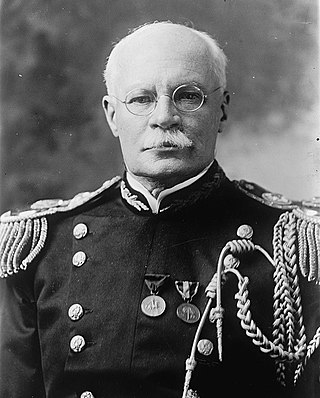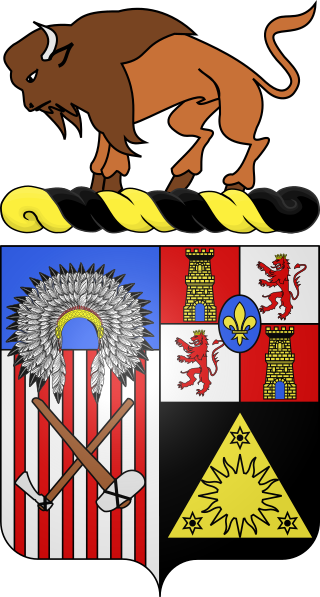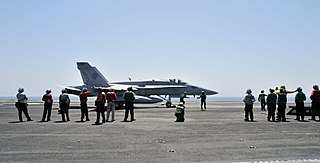
Australia joined a U.S.-led coalition in the Iraq War. Declassified documents reveal that the decision to go to war was taken primarily with a view to enhancing its alliance with the United States.

Eric Ken Shinseki is a retired United States Army general who served as the seventh United States Secretary of Veterans Affairs (2009–2014) and the 34th Chief of Staff of the Army (1999–2003). Shinseki is a veteran of two tours of combat in the Vietnam War, in which he was awarded three Bronze Star Medals for valor and two Purple Hearts. He was the first Asian-American four-star general, and the first Asian-American Secretary of Veterans Affairs.
Sergeant First Class (SFC) is typically a senior non-commissioned officer rank, used in many countries.

The withdrawal of the United States troops from Iraq began in December 2007 with the end of the Iraq War troop surge of 2007 and was mostly completed by December 2011, bringing an end to the Iraq War. The number of U.S. military forces in Iraq peaked at 170,300 in November 2007.

George William Casey Jr. is a retired four-star general who served as the 36th Chief of Staff of the United States Army from April 10, 2007, to April 10, 2011. He served as Commanding General, Multi-National Force – Iraq from June 2004 to February 8, 2007, and was in the army for his entire adult working life. He now resides in Arlington, Virginia.
Events in the year 2005 in Iraq.

Major General Hugh Lenox Scott was a United States Army officer. A West Point graduate of 1876, he served as superintendent of West Point from 1906 to 1910 and as chief of staff of the United States Army from 1914 to 1917, which included the first few months of American involvement in World War I.

The 3rd Cavalry Regiment, formerly 3rd Armored Cavalry Regiment is a regiment of the United States Army currently stationed at Fort Cavazos, Texas.

The 172nd Infantry Brigade was a light infantry brigade of the United States Army stationed at Fort Wainwright, Alaska and later moved its headquarters to Grafenwöhr, Germany. An active duty independent brigade, it was part of V Corps and was one of five active-duty, separate, brigade combat teams in the U.S. Army before its most recent inactivation on 31 May 2013.

The 9th Cavalry Regiment is a parent cavalry regiment of the United States Army. Historically, it was one of the Army's four segregated African-American regiments and was part of what was known as the Buffalo Soldiers. The regiment saw combat during the Indian and Spanish–American Wars. During Westward Expansion, the regiment provided escort for the early western settlers and maintained peace on the American frontier.

The Iraq War, sometimes called the Second Gulf War, was a protracted armed conflict in Iraq from 2003 to 2011. It began with the invasion of Iraq by the United States-led coalition that overthrew the Ba'athist government of Saddam Hussein. The conflict continued for much of the next decade as an insurgency emerged to oppose the coalition forces and the post-invasion Iraqi government. US troops were officially withdrawn in 2011.

The Multi-National Force – Iraq (MNF–I), often referred to as the Coalition forces, was a military command during the 2003 invasion of Iraq and much of the ensuing Iraq War, led by the United States of America, United Kingdom, Australia, Italy, Spain and Poland, responsible for conducting and handling military operations.

The 10th Cavalry Regiment is a unit of the United States Army. Formed as a segregated African-American unit, the 10th Cavalry was one of the original "Buffalo Soldier" regiments in the post–Civil War Regular Army. It served in combat during the Indian Wars in the western United States, the Spanish–American War in Cuba, Philippine–American War and Mexican Revolution. The regiment was trained as a combat unit but later relegated to non-combat duty and served in that capacity in World War II until its deactivation in 1944.

Florencio Xatruch was a general who led the Honduran expeditionary force against William Walker in Nicaragua in 1856.

Peter William Chiarelli is a retired United States Army general who served as the 32nd Vice Chief of Staff of the United States Army from August 4, 2008 to January 31, 2012. He also served as commander, Multi-National Corps – Iraq under General George W. Casey, Jr. He was the Senior Military Assistant to the Secretary of Defense from March 2007 to August 2008. He retired from the United States Army on January 31, 2012 after nearly 40 years of service, and was succeeded as Vice Chief of Staff by General Lloyd J. Austin III.

The 151st Cavalry Regiment was a United States Army cavalry regiment represented in the Arkansas Army National Guard by 1st Squadron, 151st Cavalry Regiment, headquartered in Warren, Arkansas, an element of the 39th Infantry Brigade Combat Team.

The Tennessee Army National Guard is a component of the United States Army and the United States National Guard. It is administered by the Tennessee Military Department. National coordination of various state National Guard units are maintained through the National Guard Bureau.

The 299th Cavalry Regiment, formerly the 299th Infantry Regiment, nicknamed "The Koa Squadron", is a unit of the Hawaii Army National Guard. It was established in 1923 from the old 2nd Hawaiian Infantry Regiment, and it served during World War II as part of the 24th Infantry Division. The name "Koa" comes from the Hawaiian word for "Warrior", and is currently headquartered in Hilo, Hawaii. The 1st and 2nd Battalions, 299th Infantry were federally activated in 1968 to support the United States Army Pacific during the Vietnam War. More recently 2nd Battalion, 299th Infantry Regiment deployed to Iraq and again after being re-flagged in 2007 as 1st Squadron, 299th Cavalry Regiment.

On 15 June 2014 U.S. President Barack Obama ordered United States forces to be dispatched in response to the Northern Iraq offensive of the Islamic State (IS), as part of Operation Inherent Resolve. At the invitation of the Iraqi government, American troops went to assess Iraqi forces and the threat posed by ISIL.

After the defeat of the Islamic State in Iraq in 2017, Iraq and the United States began discussing the partial withdrawal of American combat troops from Iraq in December 2019. In January 2020, during massive protests in Iraq, and following an escalation of tensions between the United States and Iran, the Iraqi Council of Representatives passed a non-binding measure to "expel all foreign troops from their country," including American and Iranian troops. The American Trump administration ignored the motion, but later began a partial drawdown of forces in March. U.S. combat troops have since accelerated their withdrawal from Iraq.

















